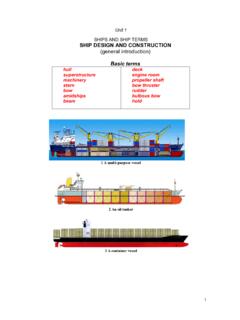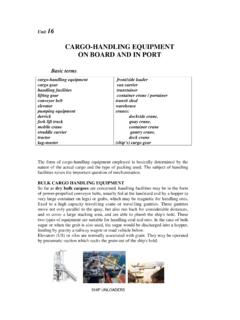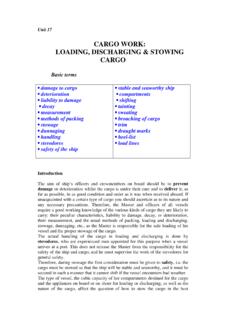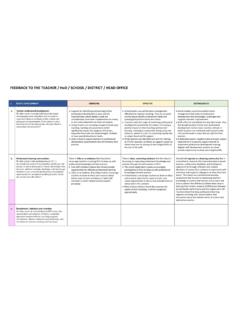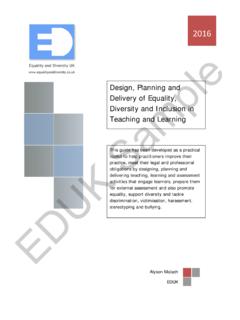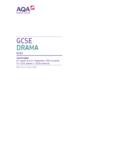Transcription of 7. Teaching translation: Sample tasks & activities
1 17. Teaching translation: Sample tasks & activities2A Sample translation coursenLength: 25 weeks at 1h30 per week nNo. of students: 22, divided into 2 groups, 2 teachers nWorkload: n6 x 250-word texts into L1/TL, the same into English/TL none long translation (1000 words) with commentary nText-types: legal act, contract, will, court decision, etc. nAssessment: ncourse-work counts for 15% nthe long translation and commentary, also 15% n3-hr examination, translate 2 x 250-word texts, one L2, one English (70%) nAims: To study the theory and practice of translation from and into English, with an emphasis on practical tasks . (Note. The priority is on the study and implementation of translation strategies, rather than on the perfecting of proficiency in L1 & L2!)nSource book:3 Translator s Competence:Transferable skills and knowledgenRead accurately nOperate effectively socio-linguistically: be aware of register, text-type nUnderstand a theory of communication and see one's role as a link in a chain of communicationnUse contextual knowledge effectively nWork to a brief, carry out instructions, adopt the attitudeof a professional nSee when extra research is needed, and do it, act autonomously nPrioritise work, pace oneself, manage one's time have work readyearly if possible nProduce reader-friendly documents, work on lay-out nStep back from one's work and evaluate it with objectivity nPost-edit one's own and other people's work (requires considerable language-awareness) nUnderstand what makes the two languages tick (similar/different)nArticulate unspoken assumptions (translation strategies, and reasons for translation decisions)4 GeneralnThe aims of the session.
2 Nteach translation into and out of the foreign languagensuggest techniques for shifting the focus of L2>L1 translation onto process and meaningnshow how language learning tasks can assist L1>L2 translation nLearning outcomesnAt the end of this session participants should be able to:nidentify approaches to translation which emphasisethe learning process rather than merely the end productnemploy a range of techniques to support and develop the ability to translate from L2 to L1nuse parallel texts to help develop L1>L2 this module you will find:nhandout (parallel translated texts: E-CRO; CRO-E)nYou will need:nsample texts for group worknflipchart and pens for feedback from participants5 APPROACHES TO TRANSLATIONnTR as a PRODUCT nTR as a PROCESSnTR as a learning process6 The translation class(es) problems of translation and translation >L1 translation as a learning processnOther L2>L1 translation issuesnApproaches to L1>L2 >L2 translation as a learning exercise71.
3 Introduction -General approachninitial tutor inputnparticipants work in language-specific pairs on a Sample text to discuss nhow to exploit it for translation into their particular target language. nafterapproximately 20 minutes each pair shares its ideas with the whole group nthe various approaches and ideas are subsequently typed up and distributed to all participants82. Common problems in translation teachingTraditional approach:nstudents write a translation in their own time, nhand it in for marking by the lecturer nwho then spends most of the class hour going over the piece, highlighting problems. nTranslation simply treated as asa vague support to general language learning, nthe process becomes in effect little more than repeated testingnThis fails to make clear how students are to learn about translation. TRADITIONAL: ntranslation used to be employed as a way of Teaching grammar particularly in translation into the foreign language, nwith the emphasis on morphology, lexis, syntax, register, etc.
4 , 93. L2>L1 L2>L1 translation traditional approach (see 2) L2>L1 translation as a learning , context, of of a L2>L1 translationas a learning Setting, context, audience(a)nstudents should never be given a decontextualisedpiece of writing. They need to be told where the text has come from, :n if it is part of a larger workn where it comes in the workn what has gone beforen what comes after also need to have information on the following:n does it introduce something?n is it arguing a specific point in a more complex argument?n is it developing an argument, a character, is it seeking to summarise, draw a conclusion, it is an article, they need to know which publication it is from and if it is:n an editorialn a news reportn a featuren a satirical piece, part of a caricature, Setting, context, audience(b)nin the real world of professional translation this sort of information translators will becrucial to the way they will approach the text nthey will want to know the audience for their translation nStudents too should be told the imagined purpose of their translation; there are two aspects to this:n why is the translation needed, what use will it be put to?
5 N who will be using the translation?nWith greater experience of translation, students can be encouraged to seek the above information themselves and to act on what they Setting, context, audience (c) nMany higher education language departments have now begun to show greater interest in translation: nas a vocational tool andnin the lessons to be learnt from those who earn their living from translationnPractice is now often based on the questions:nHow do professional translators go about their job? nWhat does a professional translator do? nIn exploring these issues teachers of translation need to shift the focus of their work nfrom the end product to the processn TR text should really be seen:nas just one text type nalongside a whole range of others (journalism, advertising, bureaucratic style, legalese, etc.) and nas something that teachers of translation need to help their students to build towards, since it is a task ideally suited to stretch moreadvanced translators133.
6 L2>L1 translation L2>L1 translation as a learning Reading phasenread the whole text thoroughly before embarking on a translationnstudents should not just read a text passively, they should be active and critical readersnWhen reading the text, students should be asking questions such as the following:nwhy has this been written this way?nwhy does this sentence or paragraph come first?nis there any reason for having this long sentence in the first paragraph, or these very short sentences?ndoes it matter if I merge sentences in my translation?ndoes it matter if I split long sentences?nwhat will be the effect if I do this?143. L2>L1 translation L2>L1 translation as a learning Reconstruction of meaningnStudents have to be shown that ntranslation is not about simply transposing items from one language to another at the level of lexis and syntax, nbut that it is about conveying meaningnThis is the first step in reconstructing meaningnthey need to see the translator as a mediator between cultural worlds, nas someone who helps those unfamiliar with a particular culture to understand and appreciate all the cultural nuances of the original text.
7 NIt is not just a test of students ability to decode, but also very much a process of encoding. nIt is about reconstructing the meaning of a message originally aimed at one audience for consumption by a different audience. nFor this reason translation is seen by some as the ultimate communicative act153. L2>L1 translation L2>L1 translation as a learning Translation dossiersnnovice translators should be encouraged to keep a translation dossier nin translation there is often little evidence that they are actually learning:nsimilar problems come up repeatedly but they usually do not make a note of them nto address this problem, students should use a dossier: narranged under alphabetical, structure or key word headings. nthey can record systematically possible translations of or strategies for coping with expressions/phrases which recur in their translation work163. L2>L1 L2>L1 translation as a learning Annotated translationsnFrom time to time get students to explain in writing the reasonsfor their translation.
8 NThis forces them to focus consciously on the act of just to put A into B, but to reflect on why they have done it. nIf they have chosen one of five possibilities in a dictionary, why have they chosen this one? nThis is a valuable exercise to do occasionally because it makes students realisethat they should be reflective they just do translation after translation, nhand them in for marking and nreceive a bit of ad hoc feedback in class,nto get any real evidence that students are learning and that they are progressing in their translation L2>L1 L2>L1 translation as a learning Correcting a translationnask students to correct an inaccurate translation which, ndepending on their proficiency can be nat a simple factual level ornmay include idiom, collocation, metaphor, etc. nThis can be an excellent source of discussion on finer linguistic task can be varied by using an incorrect translation alongside a correct one, but not telling students which is Other L2>L1 translation issuesnTranslation-task issuesnResearch toolsnQuality of Translation-task issuesnTo avoid literal and safe translations, it is important to direct students attention away from grammar and lexis towards whole-text and translation-task issues.
9 NWays to do this include:nGet students to provide a summary of a foreign text as a briefing to someone visiting the foreign country for a specific purpose; this helps to focus attention on relevance and appropriateness of material, onthe information needs of the target audience, as well as the style of students English version; this activity might be especially useful for first-year them a specific brief ( to translate a Croatian article for inclusion in a particular quality British/USnewspaper) which requires clear explication of cultural references, foreign figures or them to translate a passage for inclusion in a specialist English-language journal and to adapt their translation to the particular house style ; this might be a suitable task for final-year Research toolsnTo encourage students to adopt a pro-active approach to translation, teachers should encourage them to consult as wide a range of reference sources as possible in their translation work, including: na monolingual target-language dictionary, nbilingual dictionaries, na thesaurus, English dictionaries, and nsamples or models of writing for the particular genre or text type they are working on nparallel texts (TM, software, www)nthey should get a feel for the appropriate style by reading a few examples of the relevant genre in English).
10 Quality of EnglishnOne of the major challenges for anyone Teaching L2>L1 translation is:nto help students with poor English, nin particular those with little awareness of rhetorical strategies and linguistic registernthis is likely to be a particular problem for teachers who are non-native speakers of English. nApart from enlisting the help of a native English colleague, teachers can encourage students to employ self-help strategies here:nfor example, by asking fellow students to read their final draftand to discuss any problematic stylistic features. nStudents should come to see translation as a process of producing successive drafts, while class time can be fruitfully employed comparing versions and sensitisingstudents to issues ofnrhetoric and L1>L2 translation Traditional Translation as a (learning process)234. TR into Traditional approaches1/4nThere is often confusion over the use of translation for language learning, on the one hand, and the Teaching of translation skills on the other.



